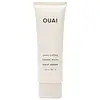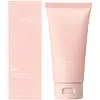Ouai Hand Crème Versus Skincotton Day Hand Cream
What's inside
What's inside
 Key Ingredients
Key Ingredients

 Benefits
Benefits

 Concerns
Concerns

 Ingredients Side-by-side
Ingredients Side-by-side

Water
Skin ConditioningCaprylic/Capric Triglyceride
MaskingCetyl Alcohol
EmollientPhenyl Trimethicone
Skin ConditioningIsododecane
EmollientMethyl Glucose Sesquistearate
EmollientGlycerin
HumectantSodium Stearoyl Glutamate
CleansingHydroxyethyl Acrylate/Sodium Acryloyldimethyl Taurate Copolymer
Emulsion StabilisingCocos Nucifera Oil
MaskingGlyceryl Stearate Citrate
EmollientCetearyl Alcohol
EmollientTheobroma Grandiflorum Seed Butter
Skin ConditioningButyrospermum Parkii Butter
Skin ConditioningAstrocaryum Murumuru Seed Butter
EmollientPersea Gratissima Oil
Skin ConditioningRosa Canina Fruit Oil
EmollientSqualane
EmollientPolysorbate 60
EmulsifyingSorbitan Isostearate
EmulsifyingGlyceryl Caprylate
EmollientXanthan Gum
EmulsifyingAlcohol
AntimicrobialSodium Phytate
Benzophenone-4
UV AbsorberTocopherol
AntioxidantSodium Chloride
MaskingCitric Acid
BufferingEthylhexylglycerin
Skin ConditioningPhenoxyethanol
PreservativeParfum
MaskingBenzyl Benzoate
AntimicrobialBenzyl Salicylate
PerfumingCitronellol
PerfumingGeraniol
PerfumingHexyl Cinnamal
PerfumingHydroxycitronellal
PerfumingLinalool
PerfumingWater, Caprylic/Capric Triglyceride, Cetyl Alcohol, Phenyl Trimethicone, Isododecane, Methyl Glucose Sesquistearate, Glycerin, Sodium Stearoyl Glutamate, Hydroxyethyl Acrylate/Sodium Acryloyldimethyl Taurate Copolymer, Cocos Nucifera Oil, Glyceryl Stearate Citrate, Cetearyl Alcohol, Theobroma Grandiflorum Seed Butter, Butyrospermum Parkii Butter, Astrocaryum Murumuru Seed Butter, Persea Gratissima Oil, Rosa Canina Fruit Oil, Squalane, Polysorbate 60, Sorbitan Isostearate, Glyceryl Caprylate, Xanthan Gum, Alcohol, Sodium Phytate, Benzophenone-4, Tocopherol, Sodium Chloride, Citric Acid, Ethylhexylglycerin, Phenoxyethanol, Parfum, Benzyl Benzoate, Benzyl Salicylate, Citronellol, Geraniol, Hexyl Cinnamal, Hydroxycitronellal, Linalool
Water
Skin ConditioningButylene Glycol
HumectantGlycerin
HumectantCyclohexasiloxane
EmollientMethylheptyl Laurate
EmollientIsopentyldiol
HumectantStearyl Alcohol
EmollientBetaine
HumectantArachidyl Alcohol
EmollientAcetamidoethoxyethanol
HumectantGlyceryl Stearate
EmollientEthylhexyl Palmitate
EmollientNiacinamide
SmoothingGlyceryl Glucoside
HumectantAscorbyl Glucoside
AntioxidantHydrolyzed Hyaluronic Acid
HumectantHydroxypropyltrimonium Hyaluronate
Sodium Hyaluronate
HumectantCeramide Ng
Skin ConditioningCeramide NP
Skin ConditioningCeramide AP
Skin ConditioningUbiquinone
AntioxidantRosa Canina Fruit Extract
AstringentFullerenes
AntimicrobialHydrolyzed Silk
HumectantDipotassium Glycyrrhizate
HumectantPhytosphingosine
Skin ConditioningAllantoin
Skin ConditioningStearic Acid
CleansingArtemisia Vulgaris Extract
Skin ConditioningPhellodendron Amurense Bark Extract
Skin ConditioningColeus Forskohlii Flower Extract
Skin ConditioningGlycosyl Trehalose
Emulsion StabilisingHydrogenated Starch Hydrolysate
HumectantPCA
HumectantSodium PCA
HumectantAlanine
MaskingArginine
MaskingIsoleucine
Skin ConditioningGlycine
BufferingSerine
MaskingThreonine
Valine
MaskingHistidine
HumectantPhenylalanine
MaskingProline
Skin ConditioningAspartic Acid
MaskingBentonite
AbsorbentSunflower Seed Oil/Hydrogenated Sunflower Seed Oil Esters
EmollientTocopheryl Acetate
AntioxidantTocopherol
AntioxidantTriethylhexanoin
MaskingCyclopentasiloxane
EmollientPEG-100 Hydrogenated Castor Oil
EmulsifyingGlyceryl Caprylate
EmollientGlyceryl Ricinoleate
EmollientGlyceryl Undecylenate
EmollientArachidyl Glucoside
EmulsifyingCetearyl Glucoside
EmulsifyingCetearyl Alcohol
EmollientBehenyl Alcohol
EmollientSodium Stearoyl Lactylate
EmulsifyingHydrogenated Lecithin
EmulsifyingPolyglyceryl-10 Pentastearate
Skin ConditioningPvp
Emulsion StabilisingXanthan Gum
EmulsifyingCarbomer
Emulsion StabilisingSodium Lactate
BufferingCitric Acid
BufferingSodium Citrate
BufferingPotassium Hydroxide
BufferingPhenoxyethanol
PreservativeParfum
MaskingWater, Butylene Glycol, Glycerin, Cyclohexasiloxane, Methylheptyl Laurate, Isopentyldiol, Stearyl Alcohol, Betaine, Arachidyl Alcohol, Acetamidoethoxyethanol, Glyceryl Stearate, Ethylhexyl Palmitate, Niacinamide, Glyceryl Glucoside, Ascorbyl Glucoside, Hydrolyzed Hyaluronic Acid, Hydroxypropyltrimonium Hyaluronate, Sodium Hyaluronate, Ceramide Ng, Ceramide NP, Ceramide AP, Ubiquinone, Rosa Canina Fruit Extract, Fullerenes, Hydrolyzed Silk, Dipotassium Glycyrrhizate, Phytosphingosine, Allantoin, Stearic Acid, Artemisia Vulgaris Extract, Phellodendron Amurense Bark Extract, Coleus Forskohlii Flower Extract, Glycosyl Trehalose, Hydrogenated Starch Hydrolysate, PCA, Sodium PCA, Alanine, Arginine, Isoleucine, Glycine, Serine, Threonine, Valine, Histidine, Phenylalanine, Proline, Aspartic Acid, Bentonite, Sunflower Seed Oil/Hydrogenated Sunflower Seed Oil Esters, Tocopheryl Acetate, Tocopherol, Triethylhexanoin, Cyclopentasiloxane, PEG-100 Hydrogenated Castor Oil, Glyceryl Caprylate, Glyceryl Ricinoleate, Glyceryl Undecylenate, Arachidyl Glucoside, Cetearyl Glucoside, Cetearyl Alcohol, Behenyl Alcohol, Sodium Stearoyl Lactylate, Hydrogenated Lecithin, Polyglyceryl-10 Pentastearate, Pvp, Xanthan Gum, Carbomer, Sodium Lactate, Citric Acid, Sodium Citrate, Potassium Hydroxide, Phenoxyethanol, Parfum
Ingredients Explained
These ingredients are found in both products.
Ingredients higher up in an ingredient list are typically present in a larger amount.
Cetearyl alcohol is a mixture of two fatty alcohols: cetyl alcohol and stearyl alcohol. It is mainly used as an emulsifier. Emulsifiers help prevent the separation of oils and products. Due to its composition, it can also be used to thicken a product or help create foam.
Cetearyl alcohol is an emollient. Emollients help soothe and hydrate the skin by trapping moisture.
Studies show Cetearyl alcohol is non-toxic and non-irritating. The FDA allows products labeled "alcohol-free" to have fatty alcohols.
This ingredient is usually derived from plant oils such as palm, vegetable, or coconut oils. There is debate on whether this ingredient will cause acne.
Due to the fatty acid base, this ingredient may not be Malassezia folliculitis safe.
Learn more about Cetearyl AlcoholCitric Acid is an alpha hydroxy acid (AHA) naturally found in citrus fruits like oranges, lemons, and limes.
Like other AHAs, citric acid can exfoliate skin by breaking down the bonds that hold dead skin cells together. This helps reveal smoother and brighter skin underneath.
However, this exfoliating effect only happens at high concentrations (20%) which can be hard to find in cosmetic products.
Due to this, citric acid is usually included in small amounts as a pH adjuster. This helps keep products slightly more acidic and compatible with skin's natural pH.
In skincare formulas, citric acid can:
While it can provide some skin benefits, research shows lactic acid and glycolic acid are generally more effective and less irritating exfoliants.
Most citric acid used in skincare today is made by fermenting sugars (usually from molasses). This synthetic version is identical to the natural citrus form but easier to stabilize and use in formulations.
Read more about some other popular AHA's here:
Learn more about Citric AcidGlycerin is already naturally found in your skin. It helps moisturize and protect your skin.
A study from 2016 found glycerin to be more effective as a humectant than AHAs and hyaluronic acid.
As a humectant, it helps the skin stay hydrated by pulling moisture to your skin. The low molecular weight of glycerin allows it to pull moisture into the deeper layers of your skin.
Hydrated skin improves your skin barrier; Your skin barrier helps protect against irritants and bacteria.
Glycerin has also been found to have antimicrobial and antiviral properties. Due to these properties, glycerin is often used in wound and burn treatments.
In cosmetics, glycerin is usually derived from plants such as soybean or palm. However, it can also be sourced from animals, such as tallow or animal fat.
This ingredient is organic, colorless, odorless, and non-toxic.
Glycerin is the name for this ingredient in American English. British English uses Glycerol/Glycerine.
Learn more about GlycerinGlyceryl Caprylate comes from glycerin and caprylic acid, a fatty acid from coconut. It has emollient and emulsifier properties.
As an emollient, it helps hydrate your skin. Emollients work by creating a barrier on your skin to trap moisture in, helping to keep your skin soft and smooth.
On the other hand, emulsifiers prevent ingredients (such as oil and water) from separating.
Learn more about Glyceryl CaprylateParfum is a catch-all term for an ingredient or more that is used to give a scent to products.
Also called "fragrance", this ingredient can be a blend of hundreds of chemicals or plant oils. This means every product with "fragrance" or "parfum" in the ingredients list is a different mixture.
For instance, Habanolide is a proprietary trade name for a specific aroma chemical. When used as a fragrance ingredient in cosmetics, most aroma chemicals fall under the broad labeling category of “FRAGRANCE” or “PARFUM” according to EU and US regulations.
The term 'parfum' or 'fragrance' is not regulated in many countries. In many cases, it is up to the brand to define this term.
For instance, many brands choose to label themselves as "fragrance-free" because they are not using synthetic fragrances. However, their products may still contain ingredients such as essential oils that are considered a fragrance by INCI standards.
One example is Calendula flower extract. Calendula is an essential oil that still imparts a scent or 'fragrance'.
Depending on the blend, the ingredients in the mixture can cause allergies and sensitivities on the skin. Some ingredients that are known EU allergens include linalool and citronellol.
Parfum can also be used to mask or cover an unpleasant scent.
The bottom line is: not all fragrances/parfum/ingredients are created equally. If you are worried about fragrances, we recommend taking a closer look at an ingredient. And of course, we always recommend speaking with a professional.
Learn more about ParfumPhenoxyethanol is a preservative that has germicide, antimicrobial, and aromatic properties. Studies show that phenoxyethanol can prevent microbial growth. By itself, it has a scent that is similar to that of a rose.
It's often used in formulations along with Caprylyl Glycol to preserve the shelf life of products.
Tocopherol (also known as Vitamin E) is a common antioxidant used to help protect the skin from free-radicals and strengthen the skin barrier. It's also fat soluble - this means our skin is great at absorbing it.
Vitamin E also helps keep your natural skin lipids healthy. Your lipid skin barrier naturally consists of lipids, ceramides, and fatty acids. Vitamin E offers extra protection for your skin’s lipid barrier, keeping your skin healthy and nourished.
Another benefit is a bit of UV protection. Vitamin E helps reduce the damage caused by UVB rays. (It should not replace your sunscreen). Combining it with Vitamin C can decrease sunburned cells and hyperpigmentation after UV exposure.
You might have noticed Vitamin E + C often paired together. This is because it is great at stabilizing Vitamin C. Using the two together helps increase the effectiveness of both ingredients.
There are often claims that Vitamin E can reduce/prevent scarring, but these claims haven't been confirmed by scientific research.
Learn more about TocopherolWater. It's the most common cosmetic ingredient of all. You'll usually see it at the top of ingredient lists, meaning that it makes up the largest part of the product.
So why is it so popular? Water most often acts as a solvent - this means that it helps dissolve other ingredients into the formulation.
You'll also recognize water as that liquid we all need to stay alive. If you see this, drink a glass of water. Stay hydrated!
Learn more about WaterXanthan gum is used as a stabilizer and thickener within cosmetic products. It helps give products a sticky, thick feeling - preventing them from being too runny.
On the technical side of things, xanthan gum is a polysaccharide - a combination consisting of multiple sugar molecules bonded together.
Xanthan gum is a pretty common and great ingredient. It is a natural, non-toxic, non-irritating ingredient that is also commonly used in food products.
Learn more about Xanthan Gum